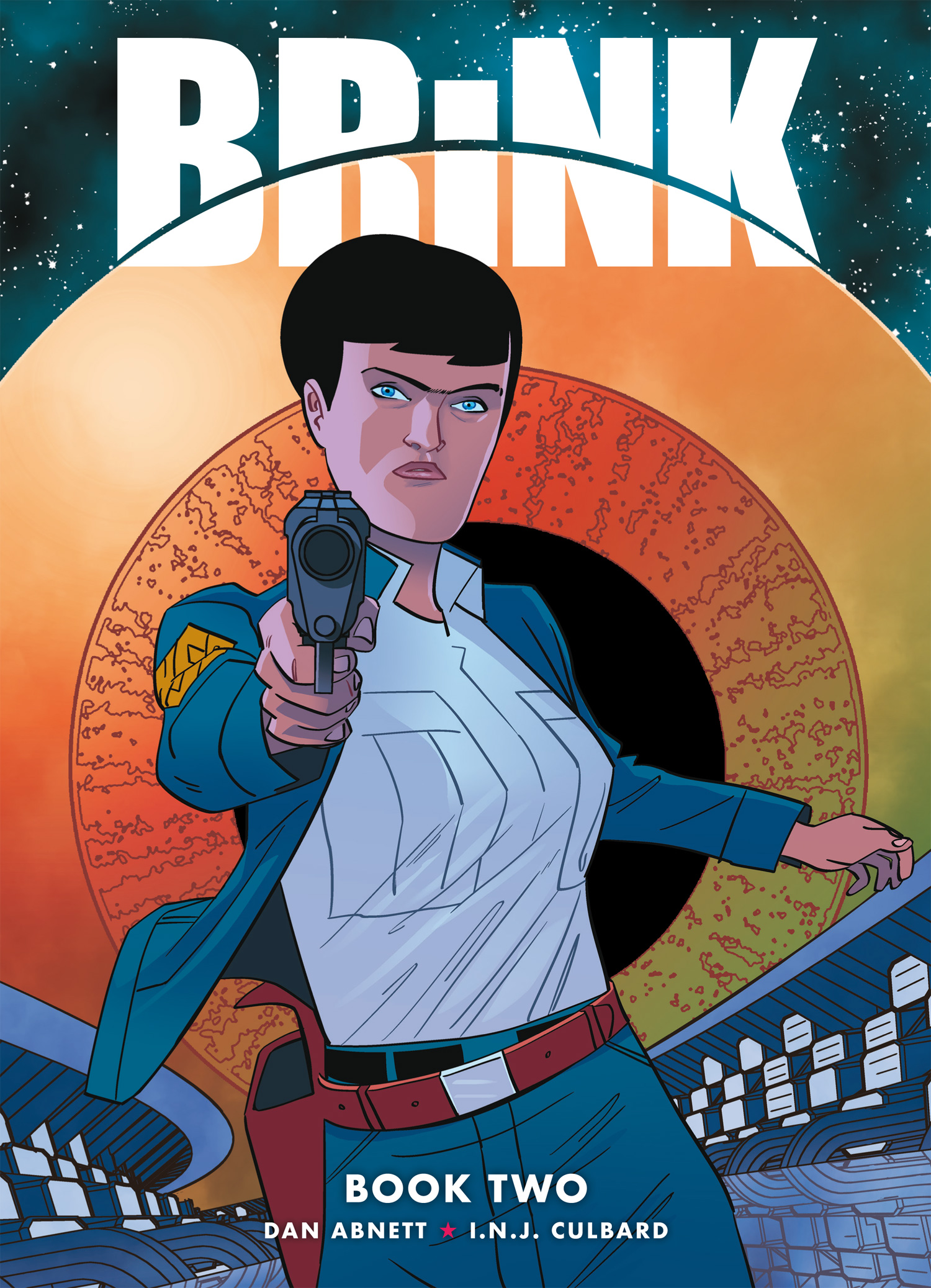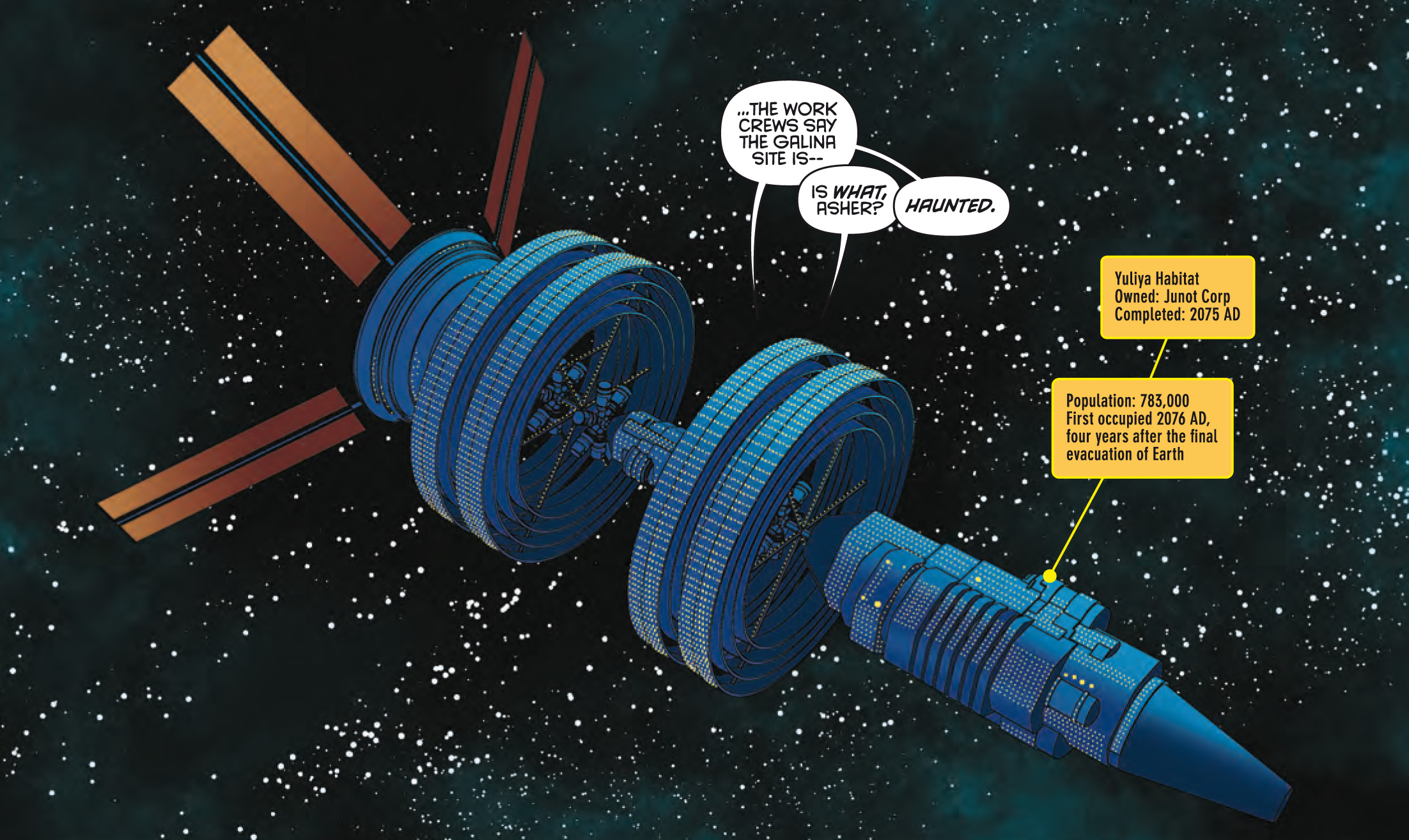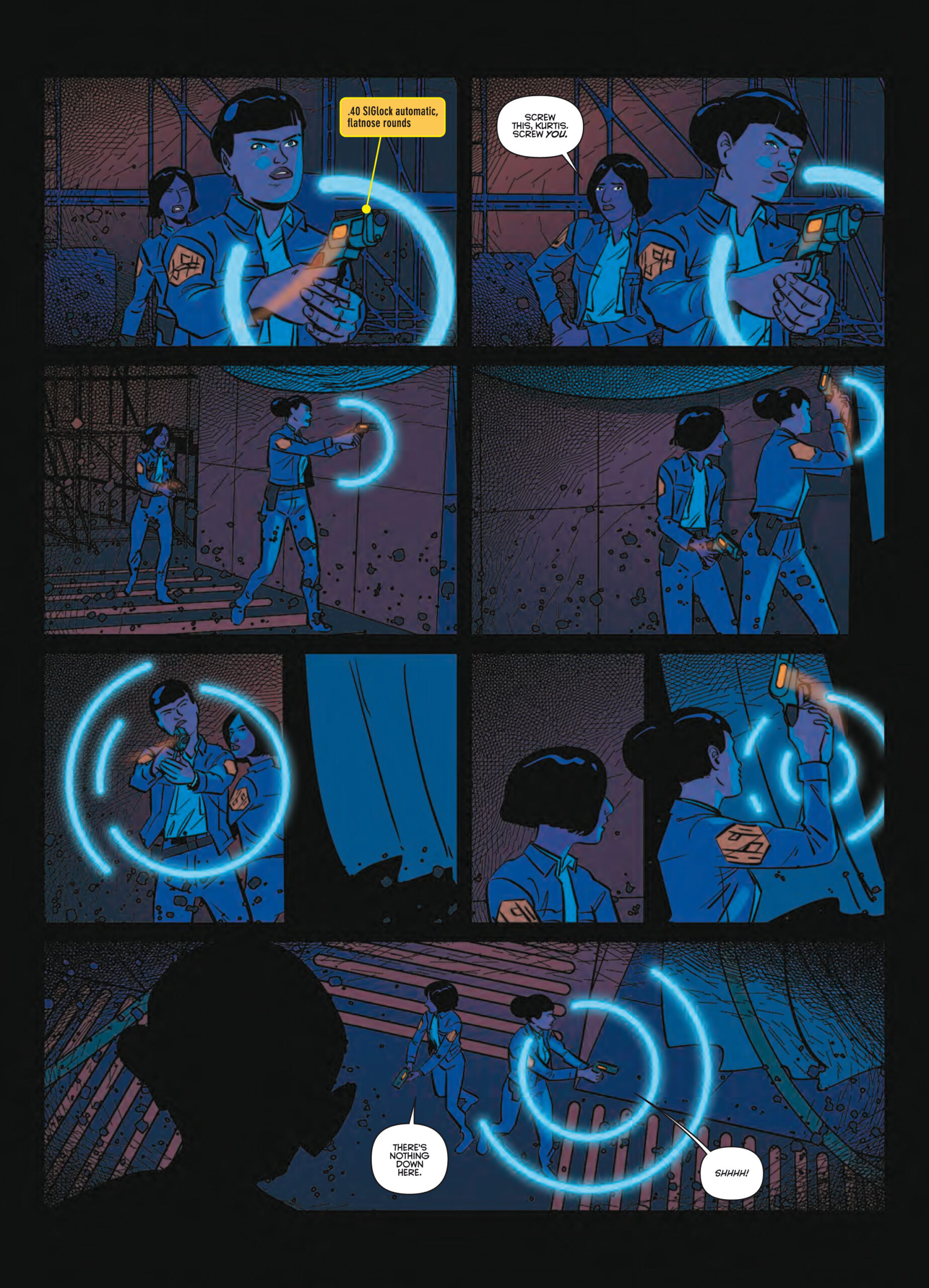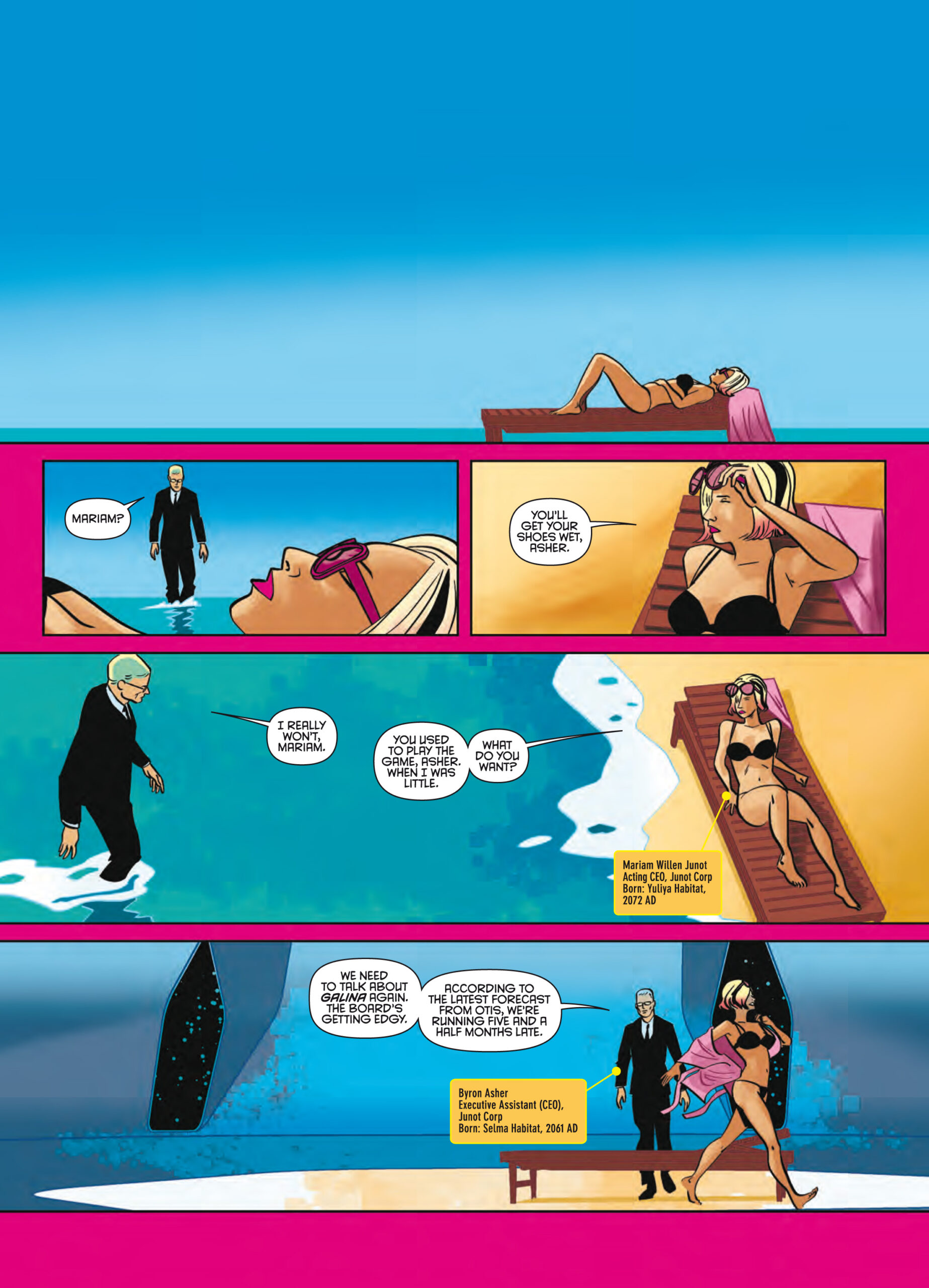INTERVIEW: Dan Abnett and INJ Culbard take it to the Brink
1st August 2018
Humanity is on the brink in this tense, atmospheric series by Dan Abnett and INJ Culbard. Forced to leave Earth for the claustrophobic confines of orbiting ‘habitats’, the only people keeping a lid on the powderkeg are the Habitat Security Division.
In volume one of Brink, we met Carl “Brink” Brinkmann and Bridget “Bridge” Kurtis, two Hab Sec officers investigating bizarre deaths and possible religious cults.
In volume two, now on her own Bridge is a private security consultant hired to investigate the bizarre and mysterious reasons part-constructed habitat Galina is running late. Everything quickly goes very wrong and we’re treated to another stunning sci-fi procedural that takes tension and cinematic vision to a wonderful level.
Book 1 and Book 2 are available separately right now from the 2000 AD store or in a bundle pack.
In volume 1, we saw Bridget Kurtis uncover a plot to set humanity on a path off the orbiting habitats, but that investigation potentially ended her career. And then, of course, there was the ominous moment in the final episode, where Mercury went dark… It’s now six months later… Can you give us a quick recap of what’s happened in Brink so far, and what can we expect from Brink in this second volume?
Dan Abnett: In the nearish future, mankind is living in ‘the Brink’. Earth is dead, and the evacuated population is living in less than ideal conditions in deteriorating habitat space stations in the solar system. Things are grim: there’s very little personal space, and people are suffering deep psychological problems. Kurtis works for the HSD (Habitat Security Division) and she’s investigating ‘sect crime’, which is the activity of ‘cults’ and other subgroups who have developed strange, deluded ideas because of the psychological erosion of life on the Brink, leading to murder and other major crimes. Or ARE they just ideas?
There’s a deep, understated thread in Brink that all the unseen horror might be true. In book 2, Kurtis gets the chance to continue her investigations, pursuing threads left after the first case. It’s going to lead her into even darker places.
You’ve previously collaborated with INJ Culbard as the artist on Dark Horse’s Dark Ages, The New Deadwardians for Vertigo and the three volume Boom! Studios series, Wild’s End. How do you find the initial genesis of any series comes about?
DA: All of these projects have come about because we talk a LOT and develop ideas, just chasing things that mutually interest us (hence the diversity). We’d worked on US projects together, but also (independently) worked for 2000 AD. It seemed silly not to try and combine our efforts on a 2K strip. Brink came out of those conversations, and it was immense fun adapting our established working style to the format of five-page weekly episodes rather than 22-page monthly books. It altered the storytelling a lot and changed the dynamic of what we found we could do.
When Brink began, we were quickly introduced to the concept of the strip as a sci-fi police procedural taking place onboard the ‘habitat’ space stations holding the remnants of humanity. And in the two protagonists of Bridge and Brink, we had that classic buddy cop dynamic going on. Throw in the cult elements to the tale, and the simple shorthand of True Detective meets Outland comes to my mind. When you’re putting together the series, are those sorts of shorthand summaries something you consider, or are they (as I suspect) annoying when thrown at your work!?
DA: No, that’s pretty close 🙂 We find we like to boil things down to a very simple top line. New Deadwardians was “The Walking Dead meets Downton Abbey”, Wild’s End was “The War of the Worlds meets the Wind in the Willows” and Dark Ages was “Kingdom of Heaven meets Starship Troopers”. They are, of course, much more than those things, and nothing like a derivative as the top lines sound, but they are good anchor points to get the idea across.
INJ Culbard: The idea itself, the nucleus, is really almost nothing compared to the worlds and the characters that inhabit them. So, Wild’s End is really using the way survival stories and anthropomorphic stories both hold a magnifying glass up to the human condition, and the stories become about inner bravery, inner peace, inner turmoil etc. But you can’t really sell that idea unless you say ‘War of the Worlds meets Wind in the Willows’. And in contrast you have Dark Ages, we just happened to have two alien invasion stories run at the same time through different publishers just because that’s how it all worked out in the end, but the two stories could not be more different in their approach and execution, because of character.
You’ve taken a simple conceptual idea and really put a huge amount of detail into the story. How does this massive world-building come about in collaboration?
DA: Again, conversation. We also pick up on each other’s work as we go. I’ll write in something that Ian then plays with in the art, or he’ll draw something that I pick up on and develop in the script. Each of our projects has a huge amount of world building: we like to know how things work, even if that information doesn’t make it to the printed page.
INJC: The crime scene at the beginning of book one of Brink, on page one, was originally a static scene (in other words the body was lying on the ground, not floating in the air) but I remember ringing Dan up and saying it’d be cool if the body was floating. Because how do you lock down a floating crime scene in space? But then Dan later uses that device for a major scene. And going back to Deadwardians, we’d had this really long conversation about vampire biology and how the blood doesn’t flow, there’s no plasma flow, no fluid, it’s just still waters. Consequently, a grieving vampire ‘applies’ their tears by painting on running mascara, and that then becomes our bit of vampire lore. And all this comes from a lot of conversation, a lot of asking one another, ‘what if?’ and trying to come up with plausible explanations that sound cool.
The speed of Brink is something that sets it apart from many of the other series in 2000 AD. The police procedural nature of the tales means a lot of the story is very dialogue heavy, punctuated by infrequent action. Yet, there’s a massive sense of tension and excitement that builds through the tale. How did you approach the storytelling elements to make the slower pace (compared to other strips) work so perfectly?
DA: Yes, agreed. We knew from the outset it was going to be very talky, and wondered if that would make it a bad fit for the prog. It really doesn’t work like anything else in 2000 AD – it defies the usual conventions of a classic 2000 AD story. But we stuck to our guns, and I think the conversational pace is what builds the detail and tension, the ‘normalcy’, so that the violence, when it comes, is more effective. There’s also no narrative and no captions, the usual methods of delivering all the exposition and world building. We wanted it all to be in dialogue (and the ‘tag’s which identify things) so that there would be a certain amount of detective work required by the reader. I think that’s what makes the world immersive. There is no “Basil Exposition”, no info-dumping, no “as you know, Steve…” moments. You have to unlock it. And, to our delight, people REALLY liked it…
INJC: Seconded. There’s a lot of acting to be done when there’s little action. So it ends up more focused on subtlety and nuance. You have to sort of guide the reader through it and curate their emotions. I tend to watch actors performances with greater interest than car chases.
With Brink’s police procedural pacing, the necessary elements of the story are slow to build. How do you satisfy the seemingly conflicting demands of the slow-build and the serial structure?
DA: I try to make sure that there’s a rhythm to each episode, so that we learn something each time. There aren’t necessarily cliff-hangers, but there’s a sense of closure, or dread or of realisation.
Now, without really wanting to give away the huge twist in volume one, there’s no getting away from the fact that volume 2 is very much a solo tale featuring Bridge, now a security consultant away from the Habitat Security Division. At what point in creating Brink volume 1 did you decide on the path the series would take when it came to Brink and Bridge’s futures?
DA: Early on. We knew where we were going. We had a tight plan in mind for the first book. After that, well… once we had that first volume in hand, we realised we knew where we wanted to go afterwards. We now have much longer plans… and that’s thanks to the confidence that came with the positive reaction to book 1.
With Volume 2, your story has isolated Bridge, and the tone is completely different. Is this something deliberate for the story?
DA: Yes. Because the actual process of the story – the pace, the dialogue, the low-key atmosphere – we wanted to avoid making it repetitive, so the shift in tone was our only option. Not for nothing, Book 3 is now underway, and it represents yet another major shift in tone.
INJC: With Book 1 there was a real sense of people practically living on top of one another, all sardines. Book 2 goes for quite the opposite, right from Page 1, Panel 1, with a solitary figure lying on a sun lounger and a big open space above them. The actual space the characters inhabit is something that comes up quite a lot, so much so it became a key point working on book 3.
The violence in Brink, when it comes, is far from the normal violence we’re used to seeing in comics. It’s quick, nasty, very realistic, and leaves those affected in shock and scared. Again, is this something you decided from the outset, or is it something that came about during the telling of the tale?
DA: Definitely. It’s grim and nasty and, I hope, quite authentic, so the reactions need to be too. That matches the over all realistic tone, the conversational pace. It’s not gung-ho, high-octane action SF. I think it’s cosmic horror.
With Brink’s definite sense of confinement, of claustrophobia, with the closed in environment of the ‘Habitats’ and the whole police procedural style of things, we could have expected something dark, full of dingy corridors, badly lit space stations falling into disrepair. Yet, with Ian’s artwork, we get so much more. How would you describe what Ian brought to Brink and do you think the series would have been as successful with any other artist?
DA: I’m just in awe of what Ian does, both on the large scale and with the intimate character work. Colour is a particularly important part of this book, and he’s brought in fantastic ideas about that (in the same way, comparative space is vital to book 3, and he’s been ingenious with that). I think the series might have worked with another artist, but it wouldn’t have been this series. It would have been an entirely different thing in terms of tone and style – Ian defines the way this works, and let’s not forget it was developed between us. It’s fair to say there wouldn’t have been a Brink to offer to another artist. This is what we both wanted to do. We’re invested. It’s an absolute favourite poroject for both of us.
Ian, how did you approach Brink as an artist and can you give us some idea of your process involved in the creation of Brink?
INJC: I’d done about two or three episodes of Book 1 before going in to hospital for some major surgery, so I had this long extended time out for recovery, during which I had an epiphany. I remembered photographs from the 1980s of New York subway trains (the interiors of carriages all covered with graffiti) and photographs of Tokyo at night. That was it. I was also in this clinical environment for about a week, drifting off to the sleep to the sound of monitors beeping intermittently, that sort of eighties sci-fi ambience. So when I was fit and able to get back to my desk, I went back and redid those first episodes, and what I did was change the color scheme completely and cover everything in graffiti. I tend to think in terms of how characters effect the environment around them so this change was pretty significant for me. I was stuck indoors, on medication I didn’t want to be on and not feeling great… that’s practically everybody onboard Odette. I was there, man.
Whilst talking of the ‘habitats’, we have seen quite a few already with interesting names… Antioch, Hesperides, Kiros, Ludmilla, Odette, Phoros. Is there any rhyme or reason to the naming you want to share at all?
DA: There might be 🙂 But we might not reveal that for a while…
Finally, with the end of volume 2, we’re left with a mystery unfolding. It has that sense of being midway through the tale. How much more Brink have you got planned?
DA: Yes, it’s pretty much a trilogy. Book 3 “High Society” debuts soon. But the world is so rich, we’ve found we have strong ideas for at least three more volumes after that. We’ll see how the audience reacts. It all builds into one, big ghastly picture, whichever characters are ultimately around to witness that. We’d love to continue exploring the Brink.
Brink Book Two is out now from all good book shops, online book retailers, comic book stores and 2000 AD‘s webshop and apps!






